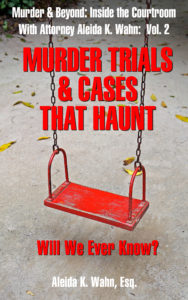
Kevin Brown had reached the end. For months he had been spiraling into despair and on October 20, 2014, he could take it no longer. Leaving his Chula Vista home and his devoted wife of 21-years, he drove to the family’s mountain cabin in Cuyamaca Rancho State Park and hung himself from a tree. At 62-years-old, his life was over. But what had driven him to such a desperate act? According to his heartbroken widow, Rebecca Brown, San Diego Police detectives were to blame. Had they pushed her gentle, loving husband over the edge with a reckless investigation and claims he was responsible for the rape and murder of a beautiful 14-year-old girl? Rebecca believed they had and filed a civil-rights and wrongful death lawsuit in federal court against the City of San Diego, suing detectives Michael Lambert and Maura Mekenas-Parga, although Lambert was the main defendant. Lambert worked as a detective for 25 years, retiring on September 8, 2017.
After five years of legal proceedings, the case finally came to trial on February 3, 2020, before U.S. District Court Judge Dana Sabraw. In an emotional closing argument, Rebecca’s attorney, Eugene Iredale, told the jury Kevin Brown was an innocent man who killed himself because of an “evil and inept” investigation, begged the jury for justice, and implored them to teach the police a lesson. Chief Deputy City Attorney Catherine Richardson countered the detectives had done nothing wrong and insisted they were just trying to do a fair and reasonable investigation. Other reasons existed for Kevin Brown’s suicide she stated. But the story began almost thirty years ago, with the heartbreaking cold-case murder of 14-year-old Claire Hough.
In the summer of 1984, Claire Hough traveled from Rhode Island to San Diego to visit her grandparents. On the night of August 23, 1984, Hough went for a walk on Torrey Pines State Beach. She never returned home. Early the next morning, a man found her strangled and mutilated body on the beach. Her murder bore similarities to the murder of 15-year-old Barbara Nantais, who had been found on the same stretch of beach six years earlier. Who could have done such horrible acts? The medical examiner conducted an autopsy on Hough and took swabs from her mouth, vagina, and anus. Although she had been sexually assaulted, no sperm was found. DNA testing was not yet available, and the investigation eventually went cold.
DNA Testing Reveals a Shocking Result
Nearly three decades later, in 2012, new testing was performed utilizing the latest DNA technology, and this time, DNA matched two men. The DNA of convicted sex offender and rapist, Ronald Tatro, was found in 13 places, including blood in seven places on Hough’s jeans, three in her underwear, and touch DNA on the zipper. Tatro was no longer alive, having died in a boating accident in 2011. The other DNA seemed unbelievable as it belonged to one of their own: Kevin Brown. He had worked as a criminalist in the San Diego Police Department’s crime lab at the time of Hough’s death, but had never worked on the case. (Brown worked as a criminalist from 1982 until 2002). A trace amount of Brown’s sperm was found on a retested vaginal swab, and the haunting question loomed: how had it gotten there?
Was the simple answer the case was one of accidental cross-contamination, attributed to lab practices in those long-ago days? In the 1980’s, it was standard practice for analysts to store their own semen samples in the lab, which they used as controls to ensure chemicals worked properly before testing of the actual evidence. The semen was dried and kept on small pieces of cloth and stored in envelopes in the crime lab’s refrigerator. Lab analysts used their own samples, but free use of others was generally accepted. Lab standards were not as stringent as today, and analysts did not always wear masks and gloves, and scissors and other instruments were washed with water or alcohol, rather than bleach, which is now known to be best at preventing contamination. As Kevin Brown stored his own semen sample at the lab, wasn’t contamination the explanation? Rebecca Brown’s suit stated it was, claiming lead detective Michael Lambert refused to accept this explanation, embarking instead on a reckless course of action which caused her husband to end his life.
The Lawsuit Claims: Violation of Kevin and Rebecca Brown’s Constitutional Rights
Rebecca Brown and the Estate of Kevin Brown raised four constitutional violations. They alleged Lambert violated their Fourth Amendment right to be free of unreasonable search and seizures by obtaining a search warrant through judicial deception and drafting an overbroad search warrant. They further alleged both Lambert and Parga seized items beyond the scope of the warrant. A judicial ruling was rendered the search warrant was overly broad, and items were seized beyond the scope. The jury would decide causation and damages for those claims, and further determine whether the warrant was obtained through judicial deception. To do so, they would have to find Lambert submitted his affidavit to a judge with one or more material misrepresentations or omissions and did so with reckless disregard for the truth.
Rebecca further claimed Lambert violated her Fourteenth Amendment right to due process and equal protection of the laws and asked for damages for the loss of the companionship of her husband. The jury would have to find there was deliberate indifference and the violation was a substantial factor for her loss, although it did not have to be the only factor.
Lastly, punitive damages were sought against Lambert, which damages were to punish and deter future conduct. The jury would have to find Lambert’s conduct was malicious, oppressive, or done with reckless disregard to the rights of the Browns.
The Original Testing and the Surprising Admission of John Simms
In 1984, Randy Gibson was an evidence technician and he went to the crime scene of Claire Hough, where he took a vaginal swab. On the witness stand, he said his practice was to do one set of two swabs, yet in this case his report of August 24, 1984, listed one. Did that mean he only used one swab or one set of two swabs? Much discussion was made about this during the trial as in 2012, criminalist David Cornacchia retested two swabs. Had a mysterious second swab appeared?
On August 25,1984, the San Diego Medical Examiner’s office conducted an autopsy on Claire Hough, taking swabs from her mouth, vagina and anus. Testing revealed “no spermatozoa.” Acid phosphatase was found though, which is an enzyme present in seminal fluid, sperm, and other bodily fluid in both men and women. However, it is found to be of a much higher concentration in semen than in any other bodily fluid. Dr. Glenn Wagner, the current San Diego Medical Examiner testified the acid phosphatase was low at 37 m I.U. (International Units), and that anything lower than 50 m I. U. is deemed unreliable. He said the acid phosphatase was probably from a male and the low result could be attributed to pre-ejaculation, sex that had occurred days earlier, or the perpetrator had a low sperm count. He further testified it was the practice of the medical examiner’s office to take two sets of swabs, giving one to the crime lab and keeping one for themselves.
John Simms, who worked for the San Diego Police Department’s crime lab for 36 years, did the original testing of the Hough evidence in 1984. He found no sperm. In sworn deposition testimony in 2016 and 2017, he stated it would have been his standard practice to use only his own semen sample. However, when he took the witness stand at the trial, he came forth with a blockbuster surprise. He now testified he may have used Brown’s semen sample and accidently contaminated the Hough evidence with Brown’s DNA. Perhaps his scissors or lab instruments had inadvertently transferred Brown’s cells to the vaginal swab.
Lambert’s Affidavit and Search Warrant – What Did He Know About Contamination?
Detective Lambert arrived in the homicide cold case unit in December of 2012, after David Cornacchia’s testing was completed. Based on the new test results, Lambert drafted an affidavit and request for a search warrant of Kevin Brown’s home. An affidavit is an officer’s sworn testimony of facts which would allow a judge to find probable cause, the legal standard to issue the warrant. Attorney Richardson told the jury the purpose of the search warrant was to find out if there was any connection between Kevin Brown and Ronald Tatro, and that the affidavit was done after a year of investigation, so there was “no rush to judgment here.” She further said the case was about what Detective Lambert did or did not know when he prepared his affidavit. His 34-page affidavit did not contain one misrepresentation or material omission she maintained. It was reviewed by Lambert’s supervisor, Sergeant Hoermen and Deputy District Attorney Andrea Freshwater. On the witness stand, both said there was no misrepresentation or material omission. Rebecca Brown’s suit claimed otherwise.
To continue reading about what happened in this heartbreaking and riveting trial, please go to Aleida K. Wahn’s book, Murder Trials We Can’t Forget And Other True Cases. Aleida was there inside the courtroom for every minute, and now shares the extraordinary details of what really happened in these gripping and unforgettable trials. Order your copy today at: https://www.amazon.com/dp/B0B2YLWD1X

About Aleida K. Wahn, Esq.


I am an attorney, award-winning true crime writer, and legal analyst of criminal cases. I cover criminal trials and write stories and books about compelling, gripping, and unforgettable cases that impact our world. I take you into the courtroom in high-profile murder trials, rape cases, crimes of passion, cases involving mental illness, deviant behavior, and more. I have a deep passion for true crime, criminal law, and all aspects of the criminal justice system. I have appeared as an expert on true crime shows, including “48 Hours,” “Snapped,” and “The Dead Files,” and provided legal analysis on high-profile criminal trials on Court TV, the Law & Crime Trial Network, Fox 5 News, ABC 10 News, and KUSI News. I also create and host shows with the Del Mar Television Producers Group, addressing criminal justice and social issues in recent criminal trials.
I provided my insight and legal analysis on Court TV and the Law & Crime Trial Network of the high-profile trial of former NFL star Kellen Winslow Jr. It was a trial that captured the nation as the heralded ex-football star with fame, fortune, and a famous name stood accused of multiple rapes and other sex crimes involving five women. As the trial delved into shocking facts, complicated legal issues, and unexpected twists and turns, I was there for every minute. After the trial, I wrote a book on the case, going behind the headlines to share the extraordinary details of what happened inside the courtroom. Judging Winslow Jr.: From NFL Star to Serial Rapist? Inside the Shocking Rape Trial of Kellen Boswell Winslow II is now available on Amazon.
I am passionate about telling true crime stories, as these penetrating stories have the power to move us all, while highlighting societal issues which need to be addressed. I have personally seen the human devastation which is present in each trial and believe there is a lesson to be learned in every single case. It is through awareness and examining critical issues society can effect change and even make new laws. To learn more, please visit: https://www.aleidalaw.com.
Read about the gripping and unforgettable trials that I have covered in my latest books:


